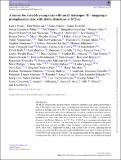A survey for variable young stars with small telescopes : II - mapping a protoplanetary disc with stable structures at 0.15 au
Abstract
The HOYS citizen science project conducts long-term, multifilter, high-cadence monitoring of large YSO samples with a wide variety of professional and amateur telescopes. We present the analysis of the light curve of V1490 Cyg in the Pelican Nebula. We show that colour terms in the diverse photometric data can be calibrated out to achieve a median photometric accuracy of 0.02 mag in broad-band filters, allowing detailed investigations into a variety of variability amplitudes over time-scales from hours to several years. Using Gaia DR2, we estimate the distance to the Pelican Nebula to be 870 +70−55 pc. V1490 Cyg is a quasi-periodic dipper with a period of 31.447 ± 0.011 d. The obscuring dust has homogeneous properties, and grains larger than those typical in the ISM. Larger variability on short time-scales is observed in U and Rc−H α, with U amplitudes reaching 3 mag on time-scales of hours, indicating that the source is accreting. The H α equivalent width and NIR/MIR colours place V1490 Cyg between CTTS/WTTS and transition disc objects. The material responsible for the dipping is located in a warped inner disc, about 0.15 au from the star. This mass reservoir can be filled and emptied on time-scales shorter than the period at a rate of up to 10−10 M⊙ yr−1, consistent with low levels of accretion in other T Tauri stars. Most likely, the warp at this separation from the star is induced by a protoplanet in the inner accretion disc. However, we cannot fully rule out the possibility of an AA Tau-like warp, or occultations by the Hill sphere around a forming planet.
Citation
Evitts , J J , Froebrich , D , Scholz , A , Eisloeffel , J , Campbell-White , J , Furnell , W , Stecklum , B , Urtly , T , Pickard , R , Wiersema , K , Dubovsky , P A , Kudzej , I , Naves , R , Morales Aimar , M , Castillo Garcia , R , Vanmunster , T , Schwendeman , E , Soldan Alfaro , F C , Johnstone , S , Gonzalez Farfan , R , Killestein , T , DelgadoCasal , J , Garcia de la Cuesta , F , Roberts , D , Kolb , U , Montoro , L , Licchelli , D , Escartin Perez , A , Perello Perez , C , Deldem , M , Futcher , S R L , Nelson , T , Dvorak , S , Mozdzierski , D , Quinn , N , Kotysz , K , Kowalska , K , Mikolajczyk , P , Fleming , G , Phillips , M , Vale , T , Dubois , F , Logie , L , Rau , S , Vanaverbeke , S , Merrikin , B , Fernandez Mananes , E , Erdelyi , E , Gonzalez Carballo , J-L , Limon Martinez , F , Long , T P , San Segundo Delgado , A , Salto Gonzalez , J L , Tremosa Espasa , L , Piehler , G , Crumpton , J , Billington , S J , D'Arcy , E , Makin , S & Dover , L 2020 , ' A survey for variable young stars with small telescopes : II - mapping a protoplanetary disc with stable structures at 0.15 au ' , Monthly Notices of the Royal Astronomical Society , vol. 493 , no. 1 , pp. 184-198 . https://doi.org/10.1093/mnras/staa158
Publication
Monthly Notices of the Royal Astronomical Society
Status
Peer reviewed
ISSN
0035-8711Type
Journal article
Description
JJE acknowledges a joint University of Kent and STFC scholarship (ST/S505456/1). AS acknowledges support through STFC grant ST/R000824/1. JC-W acknowledges the studentship provided by the University of Kent. SVM acknowledges an SFTC scholarship (1482158). KW thanks Ray Mc Erlean and Dipali Thanki for technical support of the UL50 operations. KW acknowledges funding by STFC. KW acknowledges support from Royal Society Research Grant RG170230 (PI: R. Starling). DM acknowledges the support from NCN grant 2016/21/B/ST9/01126. TK thanks the OpenScience Observatories team at the Open University for allowing the use of and operating the COAST facility. This work makes use of observations from the LCOGT network. This work was supported by the Slovak Research and Development Agency under the contract no. APVV-15-0458. This publication makes use of data products from the Near-Earth Object Wide-field Infrared Survey Explorer (NEOWISE), which is a project of the Jet Propulsion Laboratory/California Institute of Technology. NEOWISE is funded by the National Aeronautics and Space Administration. This research has made use of the SIMBAD data base, operated at CDS, Strasbourg, France. We acknowledge the use of the Cambridge Photometric Calibration Server (http://gsaweb.ast.cam.ac.uk/followup), developed and maintained by Lukasz Wyrzykowski, Sergey Koposov, Arancha Delgado, and Pawel Zielinski, and funded by the European Union’s Horizon 2020 research and innovation programme under grant agreement no. 730890 (OPTICON).Collections
Items in the St Andrews Research Repository are protected by copyright, with all rights reserved, unless otherwise indicated.

